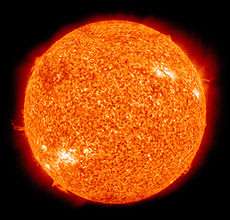Wolf number
The Wolf number (also known as the International sunspot number, relative sunspot number, or Zürich number) is a quantity that measures the number of sunspots and groups of sunspots present on the surface of the Sun.

History
Astronomers have been observing the Sun recording information about sunspots since the advent of the telescope in 1609[1]. However, the idea of compiling the information about the sunspot number from various observers originates in Rudolf Wolf in 1848[2] in Zürich, Switzerland. The produced series initially had his name, but now it is more commonly referred to as the international sunspot number series.
The international sunspot number series is still being produced today at the observatory of Brussels[3]. The international number series shows an approximate periodicity of 11 years, the solar cycle, which was first found by Heinrich Schwabe in 1843, thus sometimes it is also referred to as the Schwabe cycle. The periodicity is not constant but varies roughly in the range 9.5 to 11 years.[4] The international sunspot number series extends back to 1700 with annual values while daily values exist only since 1818.
Due to weather and researcher unavailability, "the" sunspot count is actually an average of observations by multiple people in multiple locations with different equipment, with a scaling factor k assigned to each observer to compensate for their differing ability to resolve small sunspots and their subjective division of groups of sunspots.[5]
The relative sunspot number is computed using the formula (collected as a daily index of sunspot activity):
where
- is the number of individual spots,
- is the number of sunspot groups, and
- is a factor that varies with location and instrumentation (also known as the observatory factor or the personal reduction coefficient ).[6]
A different index of sunspot activity was introduced in 1998 in the form of the number of groups apparent on the solar disc[7].
With this index it was made possible to include sunspot data acquired since 1609, being the date of the invention of the telescope.
Revision
Since 1 July 2015 a revised and updated international sunspot number series has been made available.[5][8] The biggest difference is an overall increase by a factor of 1.6 to the entire series. Traditionally, a scaling of 0.6 was applied to all sunspot counts after 1893, to compensate for Alfred Wolfer's better equipment, after taking over from Wolf. This scaling has been dropped from the revised series, making modern counts closer to their raw values. Also, counts were reduced slightly after 1947 to compensate for bias introduced by a new counting method adopted that year, in which sunspots are weighted according to their size.[5]
The accuracy of the compilation of the group sunspot number series has been questioned, motivating the development of several alternative series[9][10][11][12] suggesting different behavior of sunspot group activity before the 20th century[13]. However, indirect indices of solar activity[14][15][16] favor the group sunspot number series by Chatzistergos T. et al.[12].
See also
- Solar variation
- Joy's Law (astronomy)
References
- Vaquero, Jose M.; Vazquez, M. (2009). The Sun Recorded Through History. Springer New York. doi:10.1007/978-0-387-92790-9. ISBN 978-0-387-92790-9.
- "The Sun - History". 2001-11-25. Retrieved 2012-01-08.
- SIDC, RWC Belgium, World Data Center for the Sunspot Index, Royal Observatory of Belgium, 'year(s)-of-data'.
- Using data from SIDC for the last 300 years and running a fast FFT function on the data gives an average maximum at 10.4883 years/cycle.
- Clette, Frédéric; Svalgaard, Leif; Vaquero, José M.; Cliver, Edward W. (2014). "Revisiting the Sunspot Number". Space Science Reviews. 186 (1–4): 35–103. arXiv:1407.3231. Bibcode:2014SSRv..186...35C. doi:10.1007/s11214-014-0074-2. ISSN 0038-6308.
On average, the observed sunspot number after 1945 is a factor 1.21 higher than the expected value, again showing the influence of the weighting of sunspots according to size, coinciding with the tenure of Waldmeier
- personal reduction coefficient K
- Hoyt, D.; Schatten, K. H. (1998). "Group Sunspot Numbers: A New Solar Activity Reconstruction". Solar Physics. 179 (1): 189–219. Bibcode:1998SoPh..179..189H. doi:10.1023/A:1005007527816.
- Switching to the new Sunspot Number (1 July 2015)
- Lockwood; et al. (2014). "Centennial variations in sunspot number, open solar flux, and streamer belt width: 1. Correction of the sunspot number record since 1874" (PDF). J. Geophys. Res. Space Phys. 119 (7): 5172–5182. Bibcode:2014JGRA..119.5172L. doi:10.1002/2014JA019970.
- Svalgaard, Schatten (2016). "Reconstruction of the sunspot group number: the backbone method". Solar Physics. 291 (9–10): 2653. arXiv:1506.00755. Bibcode:2016SoPh..291.2653S. doi:10.1007/s11207-015-0815-8.
- Usoskin; et al. (2016). "A new calibrated sunspot group series since 1749: statistics of active day fractions". Solar Physics. 291 (9–10): 2685–2708. arXiv:1512.06421. Bibcode:2016SoPh..291.2685U. doi:10.1007/s11207-015-0838-1.
- Chatzistergos, T.; et al. (2017). "New reconstruction of the sunspot group numbers since 1739 using direct calibration and "backbone" methods". Astron. Astrophys. 602: A69. arXiv:1702.06183. Bibcode:2017A&A...602A..69C. doi:10.1051/0004-6361/201630045.
- Usoskin, I. (2017). "A history of solar activity over millennia". Living Reviews in Solar Physics. 14 (1): 3. arXiv:0810.3972. Bibcode:2017LRSP...14....3U. doi:10.1007/s41116-017-0006-9.
- Asvestari, E.; et al. (2017). "Assessment of different sunspot number series using the cosmogenic isotope 44Ti in meteorites" (PDF). Monthly Notices of the Royal Astronomical Society. 467 (2): 1608–1613. Bibcode:2017MNRAS.467.1608A. doi:10.1093/mnras/stx190.
- Wu, C.-J.; et al. (2018). "Solar total and spectral irradiance reconstruction over the last 9000 years". Astron. Astrophys. 620: A120. arXiv:1811.03464. Bibcode:2018A&A...620A.120W. doi:10.1051/0004-6361/201832956.
- Petrovay, K. (2019). "Solar cycle prediction". Living Reviews in Solar Physics. 7: 6. arXiv:1012.5513. Bibcode:2019arXiv190702107P. doi:10.12942/lrsp-2010-6. PMC 4841181. PMID 27194963.
